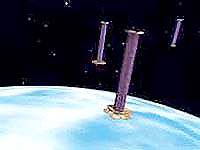MicroSat Systems Contract Raytheon For SAR Payload
MicroSat Systems, Inc. (MSI) announced a $16.4M contract with Raytheon Company Electronics Systems to provide the Synthetic Aperture Radar (SAR) payload for the Technology Satellite of
the 21st Century (TechSat 21). [TechSat-21 was a small spacecraft developed by the U.S. Air Force Research Laboratory’s Space Vehicles Directorate to test technology for formation flight of spacecraft which can rapidly change formation based on mission requirements.]
MSI, the prime integrator of TechSat 21, along with the U.S. Air Force Research Laboratory (AFRL), have created a national program team that includes Raytheon, Global Solar Energy, Broad Reach Engineering, Advanced Solutions, Inc., Lockheed Martin, TRW, ITT and General Dynamics
Advanced Information Systems.
The AFRL Space Vehicles Directorate, and the U.S. Air Force Office of Scientific Research, announced plans for a revolutionary system of formation-flying satellites that quickly adapt to rapidly changing mission requirements.
The TechSat 21 flight experiment wast to demonstrate a formation of three microsatellites flying in formation to operate as a “virtual satellite.” X-band transmit and receive payloads on each of the satellites form a large sparse aperture system. The satellite formation can be configured to optimize such varied missions as
- radio frequency (RF) sparse aperture imaging,
- precision geolocation,
- ground moving target indication (GMTI),
- single-pass digital terrain elevation data (DTED),
- electronic protection,
- single-pass interferometric synthetic aperture radar (IF-SAR), and
- high data-rate, secure communications.
Background/Related:
- History - Earth Observation History.pdf
- Singapore Launches Its First Micro-Satellite Into Space | Asian Scientist Magazine | Science, Technology and Medicine News Updates From Asia
- MO4.L09.3 - A NEW SAR SENSOR DESIGNED FOR MICRO-SATELLITES
- TechSat 21 and Revolutionizing Space Missions using Microsatellites - viewcontent.cgi
- The Air Force Research Laboratory (AFRL) The TechSat 21 Program Preliminary Design Review (PDR) was held in April 2001 and incorporated the results of extensive system trades to achieve a light-weight, high performance satellite design. An overview of experiment objectives, research advances, and satellite design is presented

1 comment:
Is this program still being funded? According to all published reports that I could locate, it was cancelled back in 2002 due to extensive over-runs and significant technical issues! If it has been brought back to life, please provide recent references to RFP's, RFI's, or other government documentation.
Post a Comment